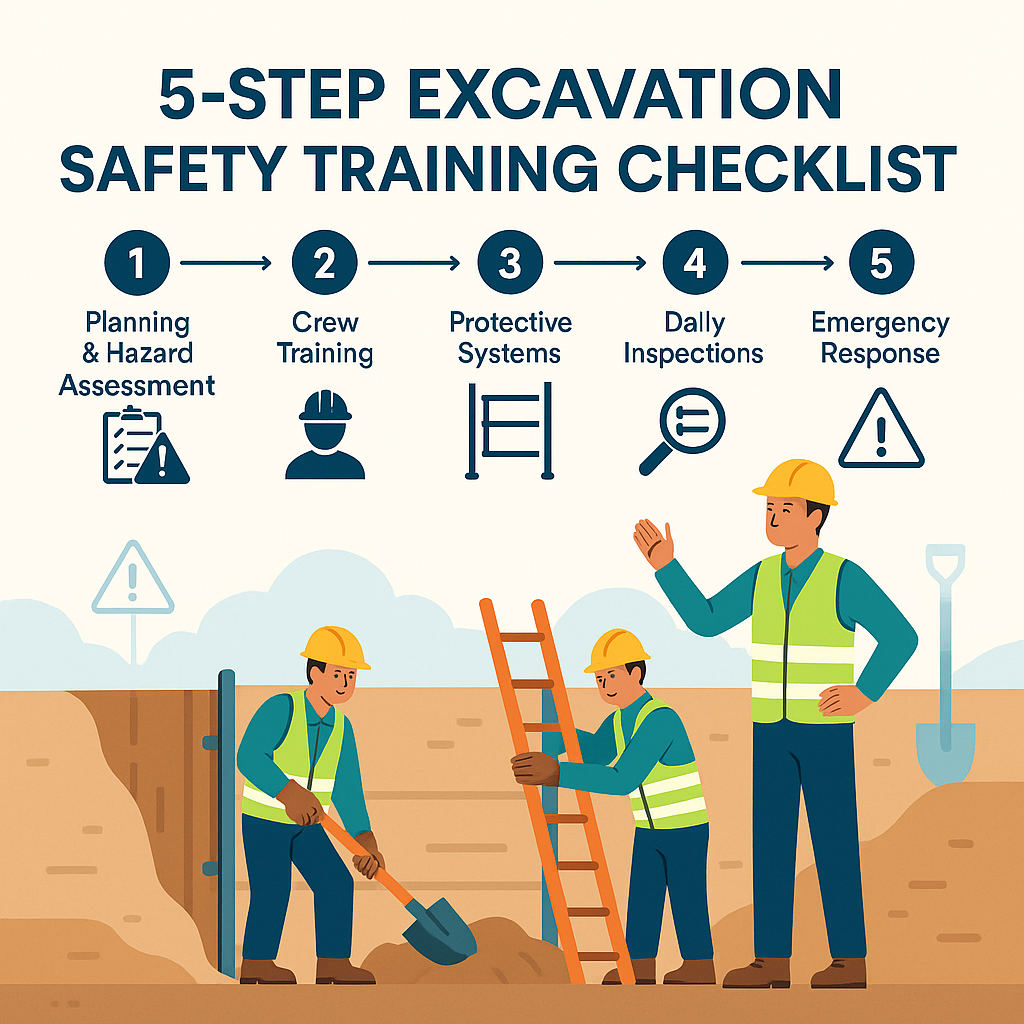
5-Step Excavation Safety Training Checklist for Supervisors
Excavation work — trenches, pits, and foundations — is one of the most hazardous activities in construction. Cave-ins, falling objects, and underground utilities pose serious risks. Supervisors play a crucial role in ensuring workers are trained, hazards are controlled, and regulations are met.
This article presents a 5-Step Excavation Safety Training Checklist for Supervisors to help protect workers and maintain compliance.
Why Excavation Safety Training Matters
- High Risk: Cave-ins can occur without warning, causing fatalities within minutes.
- Legal Compliance: OSHA 29 CFR 1926 Subpart P and similar standards require training and competent supervision.
- Efficiency: Well-trained teams work safer and faster.
- Safety Culture: Supervisors set the tone for safe excavation practices.
Step 1: Pre-Excavation Planning and Hazard Assessment
Supervisors must begin with a thorough plan:
- Identify Hazards: Soil type, weather conditions, underground utilities, adjacent structures.
- Obtain Permits: Secure necessary excavation and utility permits.
- Design Protective Systems: Sloping, benching, shoring, or shielding based on soil classification.
- Emergency Plans: Prepare for cave-ins, flooding, or hazardous atmospheres.
Example: Before digging, a supervisor contacts utility companies to mark underground lines.
Training Tip: Include a hazard mapping exercise in training sessions.
Step 2: Ensure Competent Person and Crew Training
OSHA requires a “competent person” to oversee excavations. Supervisors should:
- Verify the competent person has appropriate training.
- Ensure all crew members receive excavation safety training before starting.
- Cover key topics: hazard recognition, protective systems, emergency response.
- Maintain training records for compliance.
Example: A new hire receives excavation safety orientation before entering a trench.
Training Tip: Conduct toolbox talks on excavation hazards daily.
Step 3: Implement Protective Systems and Safe Work Practices
Protective measures save lives. Supervisors must:
- Confirm sloping, benching, shoring, or trench boxes are correctly installed.
- Keep heavy equipment and spoil piles at least 2 feet from the edge.
- Provide safe access and egress (ladders, ramps) for trenches over 4 feet deep.
- Monitor for hazardous atmospheres in deeper or confined excavations.
Example: A trench box is used for a 10-foot-deep excavation to prevent cave-ins.
Training Tip: Show before-and-after photos of proper vs. improper protective systems.
Step 4: Conduct Daily Inspections and Adjust for Conditions
Conditions can change rapidly. Supervisors should:
- Inspect excavations at the start of each shift and after rainstorms.
- Check for cracks, water accumulation, or shifting soil.
- Ensure protective systems remain in place and undamaged.
- Halt work immediately if hazards are detected until corrected.
Example: After heavy rain, a supervisor reinspects the trench and reinforces shoring before resuming work.
Training Tip: Use a standardized daily inspection checklist for supervisors.
Step 5: Establish Emergency Response and Reporting Procedures
Preparedness is key:
- Train workers on cave-in rescue procedures and evacuation routes.
- Keep emergency equipment (ladders, harnesses, stretchers) on-site.
- Ensure quick communication with emergency services.
- Document and report any incidents or near-misses to improve safety.
Example: During training, workers practice exiting a trench quickly when an alarm sounds.
Training Tip: Conduct a mock drill for cave-in response during training sessions.
Implementing the 5-Step Checklist
To make this checklist effective:
- Combine Classroom and Field Training: Teach theory and practice.
- Assess Competency: Use quizzes and on-site evaluations.
- Keep Records: Maintain training logs and inspection reports.
- Review Lessons Learned: Update procedures after incidents or changes in regulations.
Benefits of 5-Step Excavation Safety Training Checklist
- Reduced Accidents: Prevents cave-ins, falls, and utility strikes.
- Compliance: Meets OSHA/NEBOSH/ISO excavation safety standards.
- Improved Productivity: Crews work safer and more efficiently.
- Enhanced Safety Culture: Workers trust supervisors who prioritize safety.
Key Takeaways
Excavation work is high-risk but manageable. By following this 5-Step Excavation Safety Training Checklist, supervisors can ensure workers are trained, hazards are controlled, and projects run smoothly.
Suggested Internal & External Links
- External: OSHA Excavations
- Internal: 10 Must-Know Working at Height Safety Training Rules
- 7 Essential Machine Guarding Training Practices for Operators
- 5-Step Lockout Tagout Safety Training Guide for Maintenance Teams
- 10 Powerful Electrical Safety Training Tips to Prevent Shocks
- 12 Ultimate Fire Prevention Training Tips for Workers
Frequently Asked Questions
1. Why do supervisors need an excavation safety training checklist?
It helps them systematically plan, train, and inspect excavation work to prevent cave-ins and other hazards.
2. What is a “competent person” in excavation safety?
Someone trained and authorized to identify hazards and take corrective action immediately.
3. How often should excavations be inspected?
At least once per shift, after any hazard-increasing event (rain, vibration), and whenever conditions change.
4. What protective systems are used for excavation safety?
Sloping, benching, shoring, and trench boxes/shields depending on soil type and depth.
5. How can supervisors make excavation safety training engaging?
Include site visits, real case studies, photos of good/bad practices, and hands-on drills.